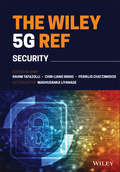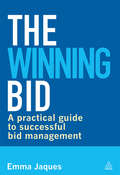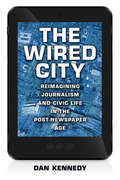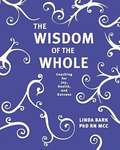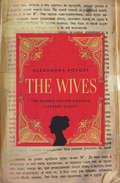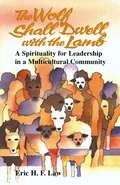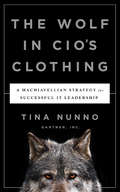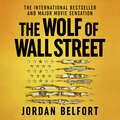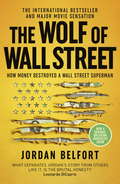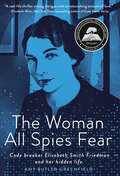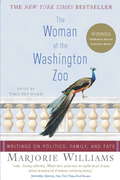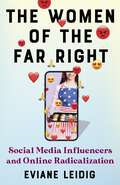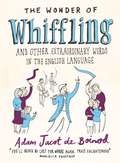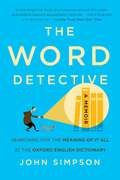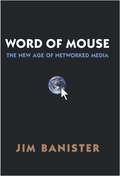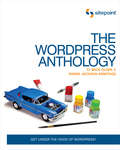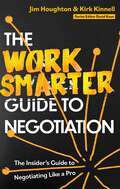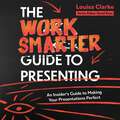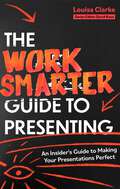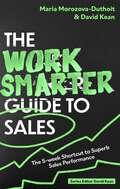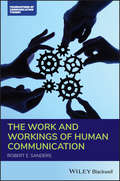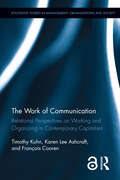- Table View
- List View
The Wiley 5G REF: Security
by Madhusanka Liyanage Periklis Chatzimisios Rahim Tafazolli Chin-Liang WangFrom the Section Editor’s Foreword by Dr. Madhusanka Liyanage, University College Dublin, Ireland. The Wiley 5G Ref: Security offers a stellar collection of articles selected from the online-only Work, The Wiley 5G Reference. It aims to provide a solid educational foundation for researchers and practitioners in the field of 5G Security and Privacy to expand their knowledge base by including the latest developments in these disciplines. The book introduces the security landscape of 5G, and significant security and privacy risks associated with the 5G networks. Then, the security solutions for different segments of the 5G network, i.e., radio network, edge network, access network, and core network, are discussed. Since 5G is developed based on network softwarization, security threats associated with key network softwarization technologies such as SDN, NFV, NS, and MEC are also presented in detail. Then, the security issues related to the new 5G and IoT services are delivered. Finally, a detailed discussion on the privacy of 5G networks is presented by considering Datafied Society. Written by leading experts in security and privacy for the telecommunication network, this book is intended to provide additional learning opportunities for a wide range of readers, from graduate-level students to seasoned engineering professionals. We are confident that this book and the entire collection of selected articles will continue Wiley’s tradition of excellence in technical publishing and provide a lasting and positive contribution to the teaching and practice of security and privacy of 5G and beyond networks.
The Winning Bid
by Emma JaquesThe Winning Bid is an easy-to-read practical guide which will teach the reader how to think like a professional bid manager. It gives essential advice on, amongst other things: PQQs and bid readiness, GIVE analysis, competitor analysis, grantwriting and funding bids best practice, freedom of Information as a research and continual improvement tool, a view from the buyer's side - featuring feedback from buyers on their experiences of being on the receiving end of bids, measuring bid performance over time, virtual team management, sharing bid best practice with other Bid Managers through APMP membership and accreditation, LinkedIn groups, the new Cabinet Office feedback channel. It will appeal to anyone engaged in bidding activity, from the bid novice to professional bid managers.
The Wired City: Reimagining Journalism and Civic Life in the Post-Newspaper Age
by Dan KennedyIn The Wired City, Dan Kennedy tells the story of the New Haven Independent, a nonprofit community website in Connecticut that is at the leading edge of reinventing local journalism. Through close attention to city government, schools, and neighborhoods, and through an ongoing conversation with its readers, the Independent's small staff of journalists has created a promising model of how to provide members of the public with the information they need in a self-governing society. Although the Independent is the principal subject of The Wired City, Kennedy examines a number of other online news projects as well, including nonprofit organizations such as Voice of San Diego and the Connecticut Mirror and for-profit ventures such as the Batavian, Baristanet, and CT News Junkie. Where legacy media such as major city newspapers are cutting back on coverage, entrepreneurs are now moving in to fill at least some of the vacuum. The Wired City includes the perspectives of journalists, activists, and civic leaders who are actively re-envisioning how journalism can be meaningful in a hyperconnected age of abundant news sources. Kennedy provides deeper context by analyzing the decline of the newspaper industry in recent years and, in the case of those sites choosing such a path, the uneasy relationship between nonprofit status and the First Amendment. At a time of pessimism over the future of journalism, The Wired City offers hope. What Kennedy documents is not the death of journalism but rather the uncertain and sometimes painful early stages of rebirth.
The Wisdom of the Whole: Coaching for Joy, Health, and Success
by Linda Bark<p>Learn all about holistic/integral coaching! If you are a professional who helps others to lead flourishing, happier lives, this book will help you become even more effective. If you are interested in learning about effective change for yourself, this book is also for you because of its fun and easy design, playful illustrations, and interactive exercises. <p>The Wisdom of the Whole invites people to look through multiple windows for exploration and action. The powerful mental tools described in this book are based on critical thinking, analysis, and planning. But we can’t stop there! The stories clients tell themselves as well as techniques such as imagery and affirmations, can help clients travel forward on a path to their goals. Ways for coaches and clients to employ intuition and the more subtle aspects of being add to the complete approach. Finding out how sense of purpose can impact motivation or shape an aspiration is also part of this model described here. The multidimensional approach enables people to move more quickly and easily toward their goals with greater authenticity, often eliminating false starts or wrong turns.
The Wives: The Women Behind Russia's Literary Giants
by Alexandra PopoffMuses and editors, saviors and publishers: Meet the women behind the greatest works of Russian literature "Behind every good man is a good woman" is a common saying, but when it comes to literature, the relationship between spouses is even that much more complex. F. Scott Fitzgerald, James Joyce, and D. H. Lawrence used their marriages for literary inspiration and material, sometime at the expense of their spouses' sanity. Thomas Carlyle wanted his wife to assist him, but Jane Carlyle became increasingly bitter and resentful in her new role, putting additional strain on their relationship. In Russian literary marriages, however, the wives of some of the most famous authors of all time did not resent taking a "secondary position," although to call their position secondary does not do justice to the vital role these women played in the creation of some of the greatest literary works in history. From Sophia Tolstoy to Véra Nabokov, Elena Bulgakov, Nadezdha Mandelstam, Anna Dostevsky, and Natalya Solzhenitsyn, these women ranged from stenographers and typists to editors, researchers, translators, and even publishers. Living under restrictive regimes, many of these women battled censorship and preserved the writers' illicit archives, often risking their own lives to do so. They established a tradition all their own, unmatched in the West. Many of these women were the writers' intellectual companions and made invaluable contributions to the creative process. And their husbands knew it. Leo Tolstoy made no secret of Sofia's involvement in War and Peace in his letters, and Vladimir Nabokov referred to Véra as his own "single shadow."
The Wolf Shall Dwell with the Lamb: A Spirituality for Leadership in a Multicultural Community
by Eric H. F. LawThis groundbreaking work explores how certain cultures consciously and unconsciously dominate in multicultural situations and what can be done about it.
The Wolf in CIO's Clothing: A Machiavellian Strategy for Successful IT Leadership
by Tina NunnoMachiavellians are few in number in IT. The massive pressure on CIOs continues to increase as the opportunities to use technology in business become more prevalent and more competitive. As CIOs often find themselves at the center of business conflict, they must not only familiarize themselves with Machiavellian tactics as a defensive weapon, but also learn to use them as an offensive weapon in extreme situations so that they can increase IT's contribution to their enterprises.As Italian political philosopher Niccolo Machiavelli implied, you're either predator or prey, and the animal you most resemble determines your position on the food chain. In The Wolf in CIO's Clothing Gartner analyst and author Tina Nunno expands on Machiavelli's metaphor, examining seven animal types and the leadership attributes of each. Nunno posits the wolf -- a social animal with strong predatory instincts--as the ideal example of how a leader can adapt and thrive.Technology may be black and white, but successful leadership demands an ability to exist in the grey. Drawing on her experience with hundreds of CIOs, Nunno charts a viable way to master the Machiavellian principles of power, manipulation, love, and war. Through compelling case studies, her approach demonstrates how CIOs and IT leaders can adjust their leadership styles in extreme situations for their own success and that of their teams.
The Wolf of Wall Street
by Jordan BelfortNOW AN AWARD-WINNING MOTION PICTURE DIRECTED BY MARTIN SCORSESE, STARRING LEONARDO DICAPRIO, MATTHEW MCCONAUGHEY AND JONAH HILL.'What separates Jordan's story from others like it, is the brutal honesty.' - Leonardo DiCaprioBy day he made thousands of dollars a minute. By night he spent it as fast as he could, on drugs, sex, and international globe-trotting. From the binge that sunk a 170-foot motor yacht, crashed a Gulfstream jet, and ran up a $700,000 hotel tab, to the wife and kids who waited for him for at home, and the fast-talking, hard-partying young stockbrokers who called him king and did his bidding, here, in his own inimitable words, is the story of the ill-fated genius they called... THE WOLF OF WALL STREET In the 1990s Jordan Belfort, former kingpin of the notorious investment firm Stratton Oakmont, became one of the most infamous names in American finance: a brilliant, conniving stock-chopper who led his merry mob on a wild ride out of the canyons of Wall Street and into a massive office on Long Island. In this astounding and hilarious tell-all autobiography, Belfort narrates a story of greed, power, and excess no one could invent - the story of an ordinary guy who went from hustling Italian ices at sixteen to making hundreds of millions. Until it all came crashing down.(P)2013 John Murray Press
The Wolf of Wall Street: More Incredible True Stories Of Fortunes, Schemes, Parties, And Prison
by Jordan BelfortStock market multimillionaire at 26. Federal convict at 36. The iconic true story of greed, power and excess.THE INTERNATIONAL BESTSELLER AND MAJOR MOVIE SENSATION, DIRECTED BY MARTIN SCORSESE AND STARRING LEONARDO DICAPRIO'What separates Jordan's story from others like it, is the brutal honesty.' - Leonardo DiCaprioBy day he made thousands of dollars a minute. By night he spent it as fast as he could. From the binge that sunk a 170-foot motor yacht and ran up a $700,000 hotel tab, to the wife and kids who waited for him for at home, and the fast-talking, hard-partying young stockbrokers who called him king and did his bidding, here, in Jordan Belfort's own words, is the story of the ill-fated genius they called THE WOLF OF WALL STREET.In the 1990s Jordan Belfort became one of the most infamous names in American finance: a brilliant, conniving stock-chopper who led his merry mob on a wild ride out of the canyons of Wall Street and into a massive office on Long Island. It's an extraordinary story of greed, power and excess no one could invent - and then it all came crashing down.'The outrageous memoirs of the real Gordon Gekko' Daily Mail'Reads like a cross between Tom Wolfe's Bonfire of the Vanities and Scorsese's Goodfellas' Sunday Times
The Woman All Spies Fear: Code Breaker Elizebeth Smith Friedman and Her Hidden Life
by Amy Butler GreenfieldAn inspiring true story, perfect for fans of Hidden Figures, about an American woman who pioneered codebreaking in WWI and WWII but was only recently recognized for her extraordinary contributions.Elizebeth Smith Friedman had a rare talent for spotting patterns and solving puzzles. These skills led her to become one of the top cryptanalysts in America during both World War I and World War II. She originally came to code breaking through her love for Shakespeare when she was hired by an eccentric millionaire to prove that Shakespeare's plays had secret messages in them. Within a year, she had learned so much about code breaking that she was a star in the making. She went on to play a major role decoding messages during WWI and WWII and also for the Coast Guard's war against smugglers. Elizebeth and her husband, William, became the top code-breaking team in the US, and she did it all at a time when most women weren't welcome in the workforce. Amy Butler Greenfield is an award-winning historian and novelist who aims to shed light on this female pioneer of the STEM community.
The Woman at the Washington Zoo: Writings on Politics, Family, and Fate
by Marjorie WilliamsOne of Washington's finest writers on people, politics, and life ? collected for the first time.
The Women of the Far Right: Social Media Influencers and Online Radicalization
by Eviane LeidigOn mainstream social media platforms, far-right women make extremism relatable. They share Instagram stories about organic foods that help pregnant women propagate the “pure” white race and post behind-the-scenes selfies at antivaccination rallies. These social media personalities model a feminine lifestyle, at once promoting their personal brands and radicalizing their followers. Amid discussions of issues like dating, marriage, and family life, they call on women to become housewives to counteract the corrosive effects of feminism and champion the Great Replacement conspiracy theory, which motivated massacres in Christchurch, El Paso, and Buffalo.Eviane Leidig offers an in-depth look into the world of far-right women influencers, exploring the digital lives they cultivate as they seek new recruits for white nationalism. Going beyond stereotypes of the typical male white supremacist, she uncovers how young, attractive women are playing key roles as propagandists, organizers, fundraisers, and entrepreneurs. Leidig argues that far-right women are marketing themselves as authentic and accessible in order to reach new followers and spread a hateful ideology. This insidious—and highly gendered—strategy takes advantage of the structure of social media platforms, where far-right women influencers’ content is shared with and promoted to mainstream audiences. Providing much-needed expertise on gender and the far right, this timely and accessible book also details online and offline approaches to countering extremism.
The Wonder of Whiffling: And Other Extraordinary Words In The English Language
by Adam Jacot de BoinodThe Wonder of Whiffling is a hugely enjoyable, surprising and rewarding tour of English around the globe (with fine coinages from our English-speaking cousins across the pond, Down Under and elsewhere).Discover all sorts of words you've always wished existed but never knew, such as fornale, to spend one's money before it has been earned; cagg, a solemn vow or resolution not to get drunk for a certain time; and petrichor, the pleasant smell that accompanies the first rain after a dry spell. Delving passionately into the English language, Adam Jacot de Boinod also discovers why it is you wouldn't want to have dinner with a vice admiral of the narrow seas, why Jacobites toasted the little gentleman in black velvet, and why a Nottingham Goodnight is better than one from anywhere else.
The Word Detective: Searching for the Meaning of It All at the Oxford English Dictionary
by John Simpson"A charmingly full, frank, and humorous account of a career dedicated to rigorous lexicographic rectitude. . . . He is an absolute hero."-Lynne Truss, New York TimesCan you drink a glass of balderdash? And what do you call the part of a dog's back it can't scratch? The answers to these questions can be found in the Oxford English Dictionary. There is no better guide to the dictionary's many wonderments than its former chief editor, John Simpson. In The Word Detective, an intensely personal memoir and a joyful celebration of English, he weaves a story of how words come into being, how culture shapes language, and how technology transforms words. A brilliant and deeply humane expedition through the world of words, The Word Detective will delight and inspire any lover of language.
The Word of Mouse
by Jim BanisterAn essential guide to how the rapid convergence of media and digital technology will unfold over the coming years, and how our conceptions of "programming" and "consumers" will be transformed by the increasing primacy of networked media. Jim Banister provides cogent analyses of how and why certain high-profile "internet" companies have become models; outlines what different kinds of businesses need to do in order to harness the still largely untapped potential of networked media; and shows why the entertainment industry's efforts to resist the changes in consumer behavior are misguided at best, and doomed at worst. This is a must-read for everyone from business and media professionals to regular consumers.
The WordPress Anthology: Get Under the Hood of Wordpress!
by Raena Jackson Armitage Mick OlinikWritten for developers, The WordPress Anthology will take you beyond the basics to give you a thorough overview of the WordPress universe. With a cookbook-style approach, you can pick and choose what you need from each chapter to suit your projects.Gain a comprehensive overview of installing, customizing and getting the most out of the web's most versatile content management systemDive into the inner mechanics of WordPress and make the code work the way you wantExplore the world of plugins, themes and APIs to add extra functionalityAdopt Multisite capabilities to host and manage your own centralized network of WordPress websitesLearn how to launch your application on a global scale with localization techniques and marketing tips
The Work Smarter Guide to Negotiation: The Insider's Guide to Negotiating Like a Pro (Work Smarter Series)
by Jim Houghton Kirk KinnellDitch the scripts and tricks for a smarter approachKirk Kinnell is a hostage negotiator and counter-terrorism expert with decades of experience. Jim Houghton has conducted complex M&A deals worth hundreds of millions. Despite their dramatically different backgrounds, they share the philosophy that negotiation is not a zero-sum game and that trust, integrity and fairness are essential to achieving a successful outcome.This book combines their vast knowledge to show you how to prepare for and conduct negotiations in almost any environment. What holds true for ending a siege or keeping a hostage alive could be the key to getting your toddler off to bed or agreeing a pay rise with your boss. Their invaluable advice will help you be resourceful and calm amid the stress and volatility of real-world negotiations.In business, this equates to winning repeat business and making more profit. In our personal lives, it means family harmony and better communities. If you are booking a wedding caterer or finding a builder for that long hoped-for renovation, it means seeing eye to eye and helping everyone get what they need on terms acceptable to them. And in hostage situations, it means saving lives. These techniques work at the highest level, and they will work for any situation you might face.The Work Smarter series:The 'Work Smarter' series of books provide shortcuts, tips and life-hacks for the development of essential business skills. The books bring together accomplished industry experts who have learned their trades at the coalface. They teach the skills ambitious businesspeople need in order to tip the playing field in their favour. It is the pirate equivalent of business advice; the antidote to conventional wisdom; 'smarter' practice over 'best practice'.
The Work Smarter Guide to Negotiation: The Insider's Guide to Negotiating Like a Pro (Work Smarter Series)
by Jim Houghton Kirk KinnellDitch the scripts and tricks for a smarter approachKirk Kinnell is a hostage negotiator and counter-terrorism expert with decades of experience. Jim Houghton has conducted complex M&A deals worth hundreds of millions. Despite their dramatically different backgrounds, they share the philosophy that negotiation is not a zero-sum game and that trust, integrity and fairness are essential to achieving a successful outcome.This book combines their vast knowledge to show you how to prepare for and conduct negotiations in almost any environment. What holds true for ending a siege or keeping a hostage alive could be the key to getting your toddler off to bed or agreeing a pay rise with your boss. Their invaluable advice will help you be resourceful and calm amid the stress and volatility of real-world negotiations.In business, this equates to winning repeat business and making more profit. In our personal lives, it means family harmony and better communities. If you are booking a wedding caterer or finding a builder for that long hoped-for renovation, it means seeing eye to eye and helping everyone get what they need on terms acceptable to them. And in hostage situations, it means saving lives. These techniques work at the highest level, and they will work for any situation you might face.The Work Smarter series:The 'Work Smarter' series of books provide shortcuts, tips and life-hacks for the development of essential business skills. The books bring together accomplished industry experts who have learned their trades at the coalface. They teach the skills ambitious businesspeople need in order to tip the playing field in their favour. It is the pirate equivalent of business advice; the antidote to conventional wisdom; 'smarter' practice over 'best practice'.
The Work Smarter Guide to Presenting: An Insider's Guide to Making Your Presentations Perfect (Work Smarter Series)
by Louisa ClarkeFact: most people would rather die than present in public. According to the National Institute of Mental Health, 75% of people rank fear of speaking in public as their number-one fear. In second place: death. For many people, presenting arouses fear of failure, of forgetting their content, of appearing nervous, of being ignored or judged by their audience, of encountering the unexpected, of technology, of going on too long or drying up. And too many presentations are lifeless, pointless and go on far too long. Yet the ability to stand up and give a presentation, a speech, a lesson or a toast in a way that captures your audience's attention and actually makes them think, feel or do something as a result is one of the most effective ways to stand out at work and in life. This book is a shortcut to making you shine on stage when you are under the spotlight or presenting on screen. It is a supremely practical guide to giving presentations that will take away the fear factor by providing the tips, techniques and tools to create and deliver presentations you'll enjoy giving and your audience will want to hear. Think of it as a friendly and experienced coach who can help you focus on the things that really make the difference in presenting so you can project the real you to the world in a way that feels comfortable and smart.The Work Smarter series:Our books provide shortcuts, tips and life-hacks for the development of essential business skills. The books bring together accomplished industry experts who have learned their trades at the coalface. They teach the skills ambitious businesspeople need in order to tip the playing field in their favour. It is the pirate equivalent of business advice; the antidote to conventional wisdom; 'smarter' practice over 'best practice'.
The Work Smarter Guide to Presenting: An Insider's Guide to Making Your Presentations Perfect (Work Smarter Series)
by Louisa ClarkeFact: most people would rather die than present in public. According to the National Institute of Mental Health, 75% of people rank fear of speaking in public as their number-one fear. In second place: death. For many people, presenting arouses fear of failure, of forgetting their content, of appearing nervous, of being ignored or judged by their audience, of encountering the unexpected, of technology, of going on too long or drying up. And too many presentations are lifeless, pointless and go on far too long. Yet the ability to stand up and give a presentation, a speech, a lesson or a toast in a way that captures your audience's attention and actually makes them think, feel or do something as a result is one of the most effective ways to stand out at work and in life. This book is a shortcut to making you shine on stage when you are under the spotlight or presenting on screen. It is a supremely practical guide to giving presentations that will take away the fear factor by providing the tips, techniques and tools to create and deliver presentations you'll enjoy giving and your audience will want to hear. Think of it as a friendly and experienced coach who can help you focus on the things that really make the difference in presenting so you can project the real you to the world in a way that feels comfortable and smart.The Work Smarter series:Our books provide shortcuts, tips and life-hacks for the development of essential business skills. The books bring together accomplished industry experts who have learned their trades at the coalface. They teach the skills ambitious businesspeople need in order to tip the playing field in their favour. It is the pirate equivalent of business advice; the antidote to conventional wisdom; 'smarter' practice over 'best practice'.
The Work Smarter Guide to Presenting: An Insider's Guide to Making Your Presentations Perfect (Work Smarter Series)
by Louisa ClarkeFact: most people would rather die than present in public. According to the National Institute of Mental Health, 75% of people rank fear of speaking in public as their number-one fear. In second place: death. For many people, presenting arouses fear of failure, of forgetting their content, of appearing nervous, of being ignored or judged by their audience, of encountering the unexpected, of technology, of going on too long or drying up. And too many presentations are lifeless, pointless and go on far too long. Yet the ability to stand up and give a presentation, a speech, a lesson or a toast in a way that captures your audience's attention and actually makes them think, feel or do something as a result is one of the most effective ways to stand out at work and in life. This book is a shortcut to making you shine on stage when you are under the spotlight or presenting on screen. It is a supremely practical guide to giving presentations that will take away the fear factor by providing the tips, techniques and tools to create and deliver presentations you'll enjoy giving and your audience will want to hear. Think of it as a friendly and experienced coach who can help you focus on the things that really make the difference in presenting so you can project the real you to the world in a way that feels comfortable and smart.The Work Smarter series:Our books provide shortcuts, tips and life-hacks for the development of essential business skills. The books bring together accomplished industry experts who have learned their trades at the coalface. They teach the skills ambitious businesspeople need in order to tip the playing field in their favour. It is the pirate equivalent of business advice; the antidote to conventional wisdom; 'smarter' practice over 'best practice'.
The Work Smarter Guide to Sales: The 5-week Shortcut to Superb Sales Performance (Work Smarter Series)
by David Kean Maria Morozova-DuthoitSome people are born with a natural 'go-get-'em' approach. For most of us, however, selling does not come naturally. This book demystifies the art of getting people to buy - whether it is as simple as convincing your friends to agree to your restaurant recommendation, or as complex as getting people to buy your million- dollar proposal at work.The book is a toolkit for self-exploration, analysis, learning and action plan development framed in a 5-week programme for building your unique sales self. Setting a clear objective for every week, it takes the reader through a simple 5-step programme: - Setting the foundation: the main principles of sales- Rational aspects of sales - Emotional aspects of sales - Connecting the dots: closuring and continuation of the sales cycle - Creating your personalised action plan and toolbox with aide memoires, frameworks and life hacks to use every dayEach chapter concludes with a summary of do's and don'ts. The last chapter includes practical tools for analysing and planning your own self-development and business development. It will accelerate your understanding of and ability to sell by raising both your self-awareness and selling self-confidence.The 'Work Smarter' series:Our books provide shortcuts, tips and life-hacks for the development of essential business skills. The books bring together accomplished industry experts who have learned their trades at the coalface. They teach the skills ambitious businesspeople need in order to tip the playing field in their favour. It is the pirate equivalent of business advice; the antidote to conventional wisdom; 'smarter' practice over 'best practice'.
The Work Smarter Guide to Sales: The 5-week Shortcut to Superb Sales Performance (Work Smarter Series)
by David Kean Maria Morozova-DuthoitSome people are born with a natural 'go-get-'em' approach. For most of us, however, selling does not come naturally. This book demystifies the art of getting people to buy - whether it is as simple as convincing your friends to agree to your restaurant recommendation, or as complex as getting people to buy your million- dollar proposal at work.The book is a toolkit for self-exploration, analysis, learning and action plan development framed in a 5-week programme for building your unique sales self. Setting a clear objective for every week, it takes the reader through a simple 5-step programme: - Setting the foundation: the main principles of sales- Rational aspects of sales - Emotional aspects of sales - Connecting the dots: closuring and continuation of the sales cycle - Creating your personalised action plan and toolbox with aide memoires, frameworks and life hacks to use every dayEach chapter concludes with a summary of do's and don'ts. The last chapter includes practical tools for analysing and planning your own self-development and business development. It will accelerate your understanding of and ability to sell by raising both your self-awareness and selling self-confidence.The 'Work Smarter' series:Our books provide shortcuts, tips and life-hacks for the development of essential business skills. The books bring together accomplished industry experts who have learned their trades at the coalface. They teach the skills ambitious businesspeople need in order to tip the playing field in their favour. It is the pirate equivalent of business advice; the antidote to conventional wisdom; 'smarter' practice over 'best practice'.
The Work and Workings of Human Communication (Foundations of Communication Theory Series)
by Robert E. SandersDiscover the fundamentals of human communication with this comprehensive and insightful resource Written in four sections, The Work and Workings of Human Communication identifies the underlying fundamentals that make our communication distinctively human. These fundamentals are the common ground that tie together the many topics and subject matters covered by the study and discipline of communication. They are also the basis of the unique contribution of the communication discipline to the social sciences. Professor, researcher and theorist Robert E. Sanders starts by focusing on what is unique about human communication and moves on to an examination of the complexities of scientific inquiry in the social sciences in general and in the communication discipline specifically. At the heart of the matter is the fact that humans are thinking beings who can make choices and therefore are not entirely predictable. This points towards new topics and questions that are likely to arise as the discipline evolves. Sanders’ approach leads to recognition of the fact that communication is at the center of how humans build our ways of life and participate together. By focusing on the underlying fundamentals that give rise to the discipline’s topics and subject areas, The Work and Workings of Human Communication encourages students to engage in independent thought about what they want to contribute by: Emphasizing the importance of communication in creating, sustaining or changing—and participating in—our ways of life on an interpersonal level and on a societal level Recognizing that human communication is inherently collaborative; people affect situations by interacting with others, not acting on others Explaining the history, current agendas and possible future of the social science side of the Communication discipline A perfect resource for new graduate students in introductory communication courses who have an interest in the social science side of the discipline, The Work and Workings of Human Communication is also highly valuable for undergraduate communication and liberal arts students who don’t possess a background in the discipline.
The Work of Communication: Relational Perspectives on Working and Organizing in Contemporary Capitalism (Routledge Studies in Management, Organizations and Society)
by Timothy Kuhn Karen L Ashcraft Francois CoorenThe Work of Communication: Relational Perspectives on Working and Organizing in Contemporary Capitalism revolves around a two-part question: "What have work and organization become under contemporary capitalism—and how should organization studies approach them?" Changes in the texture of capitalism, heralded by social and organizational theorists alike, increasingly focus attention on communication as both vital to the conduct of work and as imperative to organizational performance. Yet most accounts of communication in organization studies fail to understand an alternate sense of the "work of communication" in the constitution of organizations, work practices, and economies. This book responds to that lack by portraying communicative practices—as opposed to individuals, interests, technologies, structures, organizations, or institutions—as the focal units of analysis in studies of the social and organizational problems occasioned by contemporary capitalism. Rather than suggesting that there exists a canonically "correct" route communicative analyses must follow, The Work of Communication: Relational Perspectives on Working and Organizing in Contemporary Capitalism explores the value of transcending longstanding divides between symbolic and material factors in studies of working and organizing. The recognition of dramatic shifts in technological, economic, and political forces, along with deep interconnections among the myriad of factors shaping working and organizing, sows doubts about whether organization studies is up to the vital task of addressing the social problems capitalism now creates. Kuhn, Ashcraft, and Cooren argue that novel insights into those social problems are possible if we tell different stories about working and organizing. To aid authors of those stories, they develop a set of conceptual resources that they capture under the mantle of communicative relationality. These resources allow analysts to profit from burgeoning interest in notions such as sociomateriality, posthumanism, performativity, and affect. It goes on to illustrate the benefits that investigations of work and organization can realize from communicative relationality by presenting case studies that analyze (a) the becoming of an idea, from its inception to solidification, (b) the emergence of what is taken to be the "the product" in high-tech startup entrepreneurship, and (c) the branding of work (in this case, academic writing and commercial aviation) through affective economies. Taken together, the book portrays "the work of communication" as simultaneously about how work in the "new economy" revolves around communicative practice and about how communication serves as a mode of explanation with the potential to cultivate novel stories about working and organizing. Aimed at academics, researchers, and policy makers, this book’s goal is to make tangible the contributions of communication for thinking about contemporary social and organizational problems.
